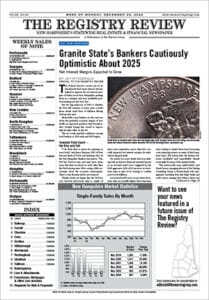
Multifamily and industrial properties were big draws for commercial real estate investors in 2020, and New Hampshire’s lenders were there to assist.
Commercial lending remained strong in New Hampshire in the midst of the COVID-19 pandemic, following a trajectory that started several years ago.
Data from The Warren Group, publisher of The Registry Review, makes clear that the pandemic wasn’t that much of a factor in 2020 in the commercial purchase loan market.
For instance, Primary Bank came in on top in number of loans, originating 35 for a total of $37.63 million, the fifth–highest volume for the year among banks. Those numbers improved from last year.
“We saw our commercial real estate portfolio – including owner and non-owner occupied – increase by $68.8 million or 65 percent over the previous year,” Bill Stone, president and CEO of Primary Bank, told The Registry Review. “New Hampshire was fortunate to have entered 2020 and the pandemic with a strong and vibrant business environment which certainly provided for a solid footing in the challenging and uncharted times as we entered 2020.”
John Mercier, executive vice president and chief lending officer for Bar Harbor Bank & Trust, said the bank had a very strong year in new business development as it focused on CRE segments that were COVID-resistant, like multifamily and industrial properties. Bar Harbor originated 22 commercial purchase loans, according to The Warren Group, despite fierce competition.
“With the decline in market lending rates creating a refinance opportunity for the owner/operators, bank deposit balances swelled from stimulus-related funding,” he said. “Thus, banks in general were in a highly liquid position which created an ultra-competitive pricing market for performing loan assets. Lender yields and bank margins were suppressed, and overall loan structure was stretched on quality lending opportunities.”
Which banks, mortgage companies and credit unions did the most business in 2020? Click here to see the full rankings.
Bar Harbor concentrated on servicing its existing portfolio of customers in 2020 and targeted new lending opportunities with strong and established sponsors known to them in its primary markets.
“Numerous banks in our market initially retreated from CRE lending during COVID, which provided our bank an opportunity to have conversations with new potential borrowers leading to new business relationships,” Mercier said.
Bank of New Hampshire was also a top community bank in the sector, originating 27 CRE loans totaling $15.42 million.
“There were a lot of projects in the works that continued to move forward, despite challenges with COVID-19,” said Ross Bartlett, the bank’s executive vice president and chief commercial banking and risk officer. “The strong demand for CRE lending was further driven by the low rate environment combined with increased liquidity as a result of government stimulus.”
Adaptability Was Key
Bank of New Hampshire employees’ ability to adapt to the strange circumstances of the pandemic made a difference to the bank’s ability to succeed, Bartlett said.
“This carried through in our ability to be flexible to meet client needs as certain deals and projects were evolving,” he said. “In addition, we have focused in recent years on becoming more efficient throughout the entire lending process, from application to origination. This has allowed us to reduce underwriting and processing timelines, leading to quicker closings and reduced resources needed to originate a loan.”
COVID-19 precautions kept Primary Bank from meeting clients or other team members face to face for part of 2020, forcing the bank to come up with new ways of doing business in order to be there for clients in a difficult time.
“It was certainly more challenging when not meeting our clients face to face, especially with loan closings,” Stone said. “Recognizing that challenge, we simply took the approach that we would find a way to get things done. One example is that we instituted the process of ‘e-sign,’ so loan documents could be signed electronically, which certainly helped during the height of the pandemic when face-to-face closings were limited. This has been extremely useful in the SBA [Paycheck Protection Program] loan process.”
Primary Bank also committed to being creative and flexible in structuring loan terms that fit clients’ needs, he said.
Low Rates Drove Customers
Banks have also been able to take advantage of an uptick in the numbers of new customers jumping into real estate investment in order to take advantage of the strong rental market, while existing customers looked to take advantage of the low interest rate environment and strong demand for housing and warehouse space to expand their holdings.
Mercier noted Bar Harbor Bank & Trust’s commercial real estate lending team has been active with expansion opportunities from existing clients and new lending opportunities with prospects while its traditional commercial and industrial lending teams have focused on serving existing clients and assisting them through the COVID period with PPP loans and other programs.
“While early on, it appeared as though COVID would have a negative effect on CRE values, lease up rates, etc., once the government stimulus began circulating in the economy, demand for CRE was strong,” Bank of New Hampshire’s Bartlett said. “As customers took stock of the situation, as well as assessed their own financial standing, many of them continued with expansion projects, investment real estate purchases and future plans. This has continued through today with strong demand.”

